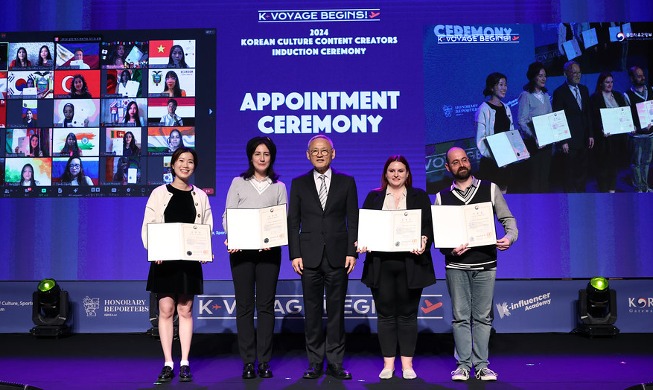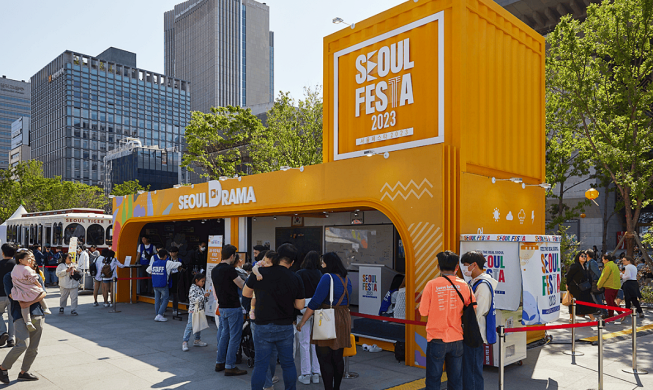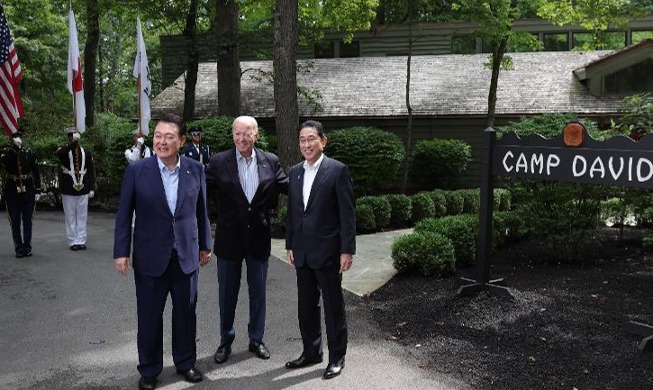-
 Korea.net's 24-hour YouTube channel
Korea.net's 24-hour YouTube channel- NEWS FOCUS
- ABOUT KOREA
- EVENTS
- RESOURCES
- GOVERNMENT
- ABOUT US

| Open House Seoul is an annual architecture festival that features the capital's most notable buildings, venues and architectural studios. Every October, the program allows the public to visit otherwise private spaces guided by an expert and experience architecture that inspires the urban imagination. |
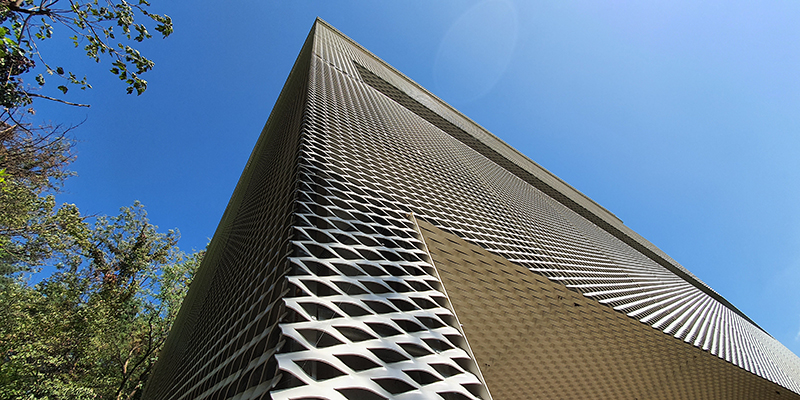
Gugi-dong House is a three-story residence built at the foot of Bukhansan Mountain, and white, expanded metal was added to the exterior of the concrete structure to increase heating efficiency. (Lee Junhyun)
By Lee Hana
Seoul | Oct. 12, 2019
Gugi-dong House
(Cho Byoungsoo, Lee Jihyun, Yoon Jayoon)
It took a steep hike to reach the gates of Gugi-dong House, a residence built at the foot of Bukhansan Mountain on Seoul's northern periphery. With all of us a little short of breath, we entered the living room and kitchen area on the first floor, greeted by architect Cho Byoungsoo of BCHO Architects Associates.
"This was my first time building in this neighborhood, and I must say Bukhansan Mountain viewed from below the hill is quite beautiful," he said, introducing the three-story house made of concrete and finished with white, expanded metal on the exterior.
"The plot behind the house is actually a greenbelt with restrictions, reducing the land price, but because of it, we can see all the way to Bukhansan National Park from out back. I knew we had to create an outdoor space on the top floor to take advantage of the panoramic views."
We climbed the stairs past the bedrooms on the second floor to see the rooftop for ourselves, and the decked space bathed in sunlight left everyone speechless. Not only did the rooftop offer views of the city, the back balcony looked out into a lush forest, filling the space with a fresh breeze. The rooftop was definitely the highlight and a source of envy of this house on a hill.
As our tour drew to a close, the homeowner popped out to say hello to the group in the front yard. "Before moving into this house, our family used to live in Ichon-dong at an apartment complex overlooking the river for 25 years. Since moving here a year ago, I've been enjoying the mountains and fresh air," she said, wishing us a safe trip back.
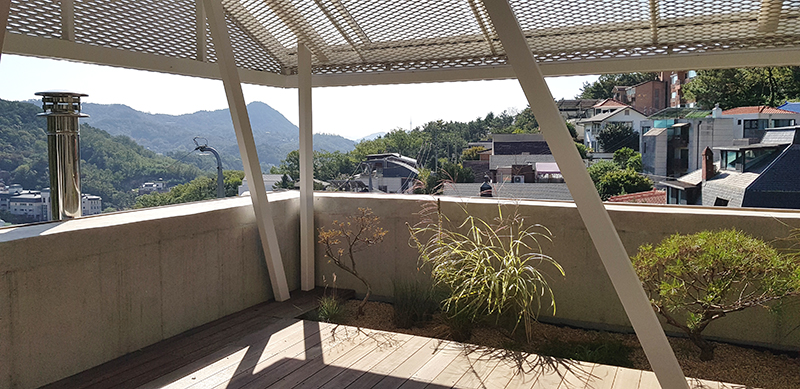
Gugi-dong House has an open rooftop on the third floor with panoramic views of the city and Bukhansan Mountain. (Lee Hana)
This year's Open House Seoul kicked off on Oct. 12 starting with tours of Gugi-dong House and the residential compound Hwa Un Won in Bongcheon-dong of Seoul's Gwanak-gu District.
Running until Oct. 20, this year's program will display over 120 locations to the public including 78 open house sites, 17 architectural studios and 26 "Visit Yourself" sites that require no preregistration.
Several of the open house themes explored this year include "The Evolving House," which looks at changing living spaces in the urban environment, and "When an Office Building Becomes a Brand," which explores work spaces for companies like Hyundai Card and the real estate developer SK D&D. Other topics such as "Universities and Their Forms" and "Reimagining the City's Contemporary Heritage" will also be covered.
The architect with the open house spotlight this year is Kim Chan-joong, whose expansive portfolio includes projects like Place 1, KEB Hana Bank's futuristic office building located in southern Seoul, and the seaside Kosmos Hotel on Ulleung-do Island in the East Sea.
Works by Kim Joong-up (1922-1988), one of Korea's most prominent first-generation architects, and Japanese-born Korean architect Itami Jun (1937-2011) will also be featured.
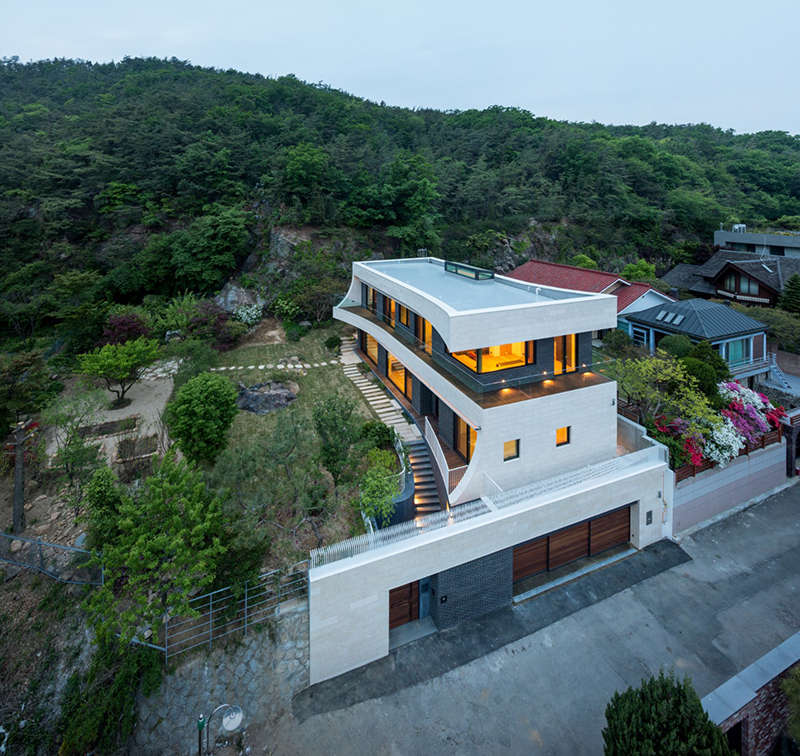
Gwacheon Seon Yu Jae House is a private residence built on Gwanaksan Mountain. Thanks to its location, this home has unobstructed views of the mountains and an open field in each room. (Shin Gyeong-sup for Open House Seoul)
Before the start of this year's program, Korea.net on Oct. 10 interviewed Lim Jinyoung, head of Open House Seoul, to hear her thoughts on the program, now in its sixth year.
"Several years ago, discussions on architecture were usually one-dimensional. But now, people can recognize well-made structures and are more aware of the role architecture plays in everyday life. That's the major difference," said Lim, an architectural journalist and editor by trade.
"That regular people can enjoy good architecture and participate in our program with such enthusiasm is a great source of joy. It feels like huge compensation for all the hardships we've encountered along the way."
Lim also thanked all the architects who participated in the program for showing their support for the cause.
"Open House Seoul not only opens doors to buildings, it's an organization that can research cities, create content and tackle deeper issues in urban living," she said, adding that she wishes to further develop Open House Seoul's research arm and its capacity for community engagement.
Furthermore, she said she hopes to expand the program to other cities nationwide.
"Places like Incheon, Busan, Gunsan and Mokpo have so much to give to residents and visitors alike. If we launched the program in those cities and opened locations once a year, the attraction of those cities would be tremendous," she said.
Open House Seoul is a free program, and those wishing to participate can sign up during the registration period, which is usually a week before the start date.
More information can be found at the following website:
https://www.ohseoul.org
hlee10@korea.kr
Most popular
- Ceremony in Seoul inducts 2,641 content creators of Korean culture
- Cultural spring festival Seoul Festa to start on May 1
- Band Second Moon spreads fusion sound on California tour
- Entrepreneur promotes rural cuisine handed down orally
- First Korean-style 'taxi driver' diner opened in New York



